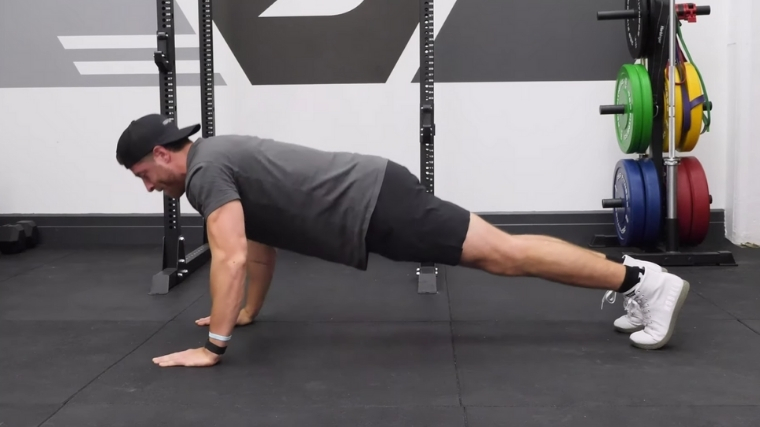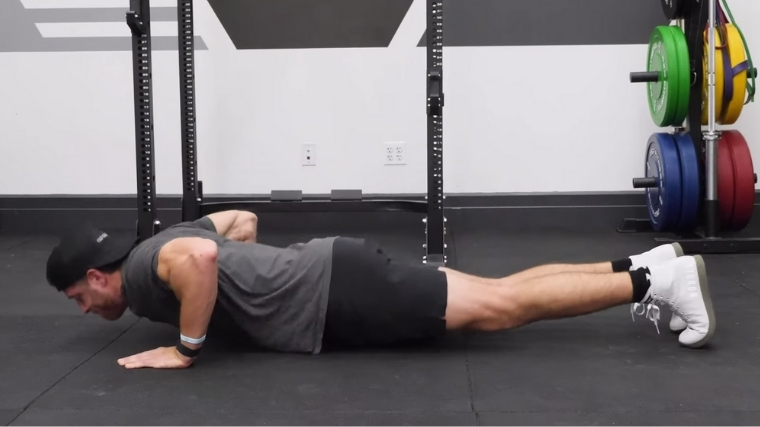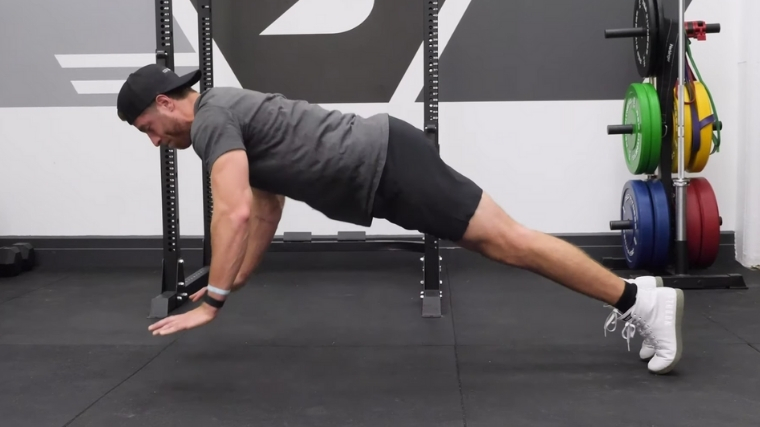Push-ups have been around for ages and are a widely embraced movement used to test upper body strength and fitness. Plyometric training has some amazing benefits — more power and strength — yet only with lower body training. While plyometric push-ups are mainly seen in ego-driven push-up contests, they do actually serve a physiological purpose.
Below, we’ll show you how to do the plyo push-up, outline variations and alternatives, and answer some common questions.
- How to Do the Plyometric Push-Up
- Benefits of the Plyometric Push-Up
- Muscles Worked by the Plyometric Push-Up
- Who Should Do the Plyometric Push-Up
- Plyometric Push-Up Sets, Reps, and Programming Recommendations
- Plyometric Push-Up Variations
- Plyometric Push-Up Alternatives
- Frequently Asked Questions
How to Do the Plyometric Push-Up
The below step-by-step guide discusses how to perform the plyometric push-up. There are many variations of this specific push-up. You can perform clapping push-ups, superman push-ups, assisted plyometric push-ups with a resistance band wrapped around your waist. The variation below is the most basic plyometric push-up — where you explode off the floor and land softly back on your hands. Master this simple plyo push-up first before progressing to more complicated variations.
Step 1 — Assume a Plank Position
The starting phase of a push-up is a plank, where you place your hands underneath your shoulders and keep your back in a straight line. Brace your core and rotate your elbows, so they’re facing outward about 45 degrees from your body.
Form Tip: Assume a plank with the torso rigid and back flat. The head should remain in a neutral position.
Step 2 — Lower Yourself to the Ground
Once you are set, pull your elbows to the back as if you’re performing a bent-over row. This sounds like an odd cue for a push-up, but you’ll find it activates your upper back muscles as your chest lowers towards the floor. Do not let your head or shoulders slouch forwards towards the floor. Rather, think about pulling your sternum in between your hands.
Form Tip: The thighs, hips, and chest should all make contact on the floor simultaneously.
Step 3 — Explode Upwards with Chest and Arms
Once your chest has touched the floor, press yourself away and upwards by trying to reach your hands into the floor. Push yourself away from the floor, and focus on keeping tension in the upper back.
Form Tip: Stay rigid in the torso and be sure not to let the hips sag in the upwards movement of the push-up.
Benefits of the Plyometric Push-Up
Regardless of your training goals, adding the plyometric push-up into your routine can have some serious payoff. You’ll become more powerful, stronger, and set yourself up for gains.
Increased Rate of Force Production
Plyometric exercises force the muscle units to contract faster to promote enough force to propel the body into space (off the floor). The benefit of developing this capacity is that the body will then learn to promote force more explosively, which can benefit even slow speed movements (such as one-rep max attempts).
Increased Motor Unit Recruitment
When we perform certain exercises or movement tasks, many of our muscle units are firing. Typically, slow-twitch fibers are recruited during longer endurance-based training while fast-twitch fibers play for heavy lifts and explosive training.
Enhanced Pressing Performance
This benefit is really the culmination of the first two. Because the plyometric push-up makes your more explosive better activates fast-twitch muscle fibers in the upper body, you’ll be able to press more weight in moves like the overhead press and bench press. That said, the plyo push-up is an accessory to your standard strength training. You won’t increase your strength with this movement alone. Rather, think of it as a way to shore up a specific weakness — explosivity in this case — to boost your pressing.
Muscles Worked by the Plyometric Push-Up
Here are the main muscles involved in the plyometric push-up and how they work.
[Related: Cluster Sets Are the Intensity Booster Your Workouts Need]
Pectorals
The chest muscles are the main driver in all push-up variations. In this case, they work to drive the body off the floor and then slow the body down as your hands land back on the floor.
Triceps
Your triceps extend the elbow joints. You’ll need to press as hard as possible when you flex the elbow to get as much momentum as possible for the plyometric portion of the push-up.
Front Deltoids
In the plyometric push-up, the front deltoids assist the chest and triceps in the overall pressing movement. For optimal shoulder health, be sure to eccentrically load the chest and triceps with most of the load rather than the front delt.
Who Should Do the Plyometric Push-Up?
The plyometric push-up can be used with strength, power, and fitness athletes to increase upper body pressing strength and explosiveness.
Strength and Power Athletes
- Powerlifters and Strongman Athletes: The plyometric push-up can aid in the force production of the chest and triceps muscles, translating to a stronger bench press. That said, stronger athletes may opt to perform banded bench presses to achieve similar benefits but with a more specific-specific focus.
- Olympic Weightlifters: The ply push-up doesn’t have a lot of use for weightlifters. After all, so much of their training is already explosive and heavy. However, a few sets of plyo push-ups strategically placed in a program wouldn’t hurt.
[Read More: Train for 100 Push-Ups a Day]
General and Functional Fitness
Anyone can reap the benefits listed above. Really, the plyometric push-up is easy to learn and safe (so long as you catch yourself and don’t bang your head on the ground.)
Plyometric Push-Up Sets, Reps, and Programming Recommendations
Below are two primary training goals and programming recommendations when programming the plyometric push-ups into workouts. To gain muscle, you’ll want to focus on movements that target the muscles in play — the triceps, shoulders, and chest — individually. For triceps, try skull crushers. To enlarge your shoulders, do dumbbell presses. And stick with dumbbell pullovers for your chest.
To Gain Strength
Perform three to five sets of five to 10 repetitions with 90-120 second rest periods with moderate to heavy loads. While there are no exact guidelines as to how to use the plyometric push-up in a program, adding tempos, loads, and partial ranges of motion (at times) can all be used to facilitate strength development further.
To Improve Muscle Endurance
Some lifters may want to train for more muscular endurance. While this protocol can vary drastically in loading, rest periods, and training volume (sets and reps), start by doing two to three sets of 20-30 repetitions with 45-60 second rest with light to moderate loads.
Plyometric Push-Up Variations
Below are two plyometric push-up variations to improve strength, size, and overall muscle growth of the chest, triceps, and upper body.
Close-Grip Plyometric Push-Up
Close-grip plyometric push-ups are done to increase loading on the triceps and limit shoulder strain. Close-grip push-ups are a solid option for lifters looking to isolate the triceps and/or improve lockout strength.
[Related: The Best Kettlebells for Beginners, CrossFit, and Cardio]
Band-Assisted Plyometric Push-Up
If you lack power, you can loop a resistance band around a pull-up bar or the top of a squat rack and lay inside the band (so it’s around your stomach). As you drive up, the band will shorten and help you lift off of the ground. As you get stronger, you can either shorten the distance between you and the band or use a lighter, thinner band. (Of course, this is a great variation to use for standard push-ups, too, if you need a boost.)
[Related: Best Dumbbells for Durability, Adjustability, Premium Options, and More]
Plyometric Push-Up Alternatives
Below are three plyometric push-up alternatives that you can do to vary programming, challenge lifters, and more.
Banded Bench Press
The banded bench press can increase strength and rate of force production during the bench pressing movement. This can be a great alternative to the plyometric push-up for lifters who rely on the bench press movement for sport specificity. This is also a great way to introduce power training to lifters who may not perform the plyometric push-up properly.
[Related: The 8 Best Barbell Exercises for Mass, Strength, and Power]
Lying Med Ball Chest Throw
The lying medicine ball chest throw is like a close grip floor press done explosively. This is very similar to the plyometric push-up in that it builds explosive power of the upper body pressing muscles. If someone cannot perform push-ups, this is a great alternative. Simply grab a medicine ball, lay on your back, set your core, and then press. Be sure to catch the ball, so you don’t smash yourself in the face.
[Related: The 7 Best Smith Machine Exercises and How to Do Them]
Smith Machine Bench Press “Throws”
Set up a smith machine and load the bar with about 30 to 50 percent of what you typically bench press for one rep. Lay down, grip the barbell, lower it to your chest, and then press it up. Allow the bar to leave your hands, and then catch it as it comes down. The fixed barbell allows you to do this move, as you don’t have to worry about the barbell crashing behind you or in front of you.
[Related: Best Pre-Workout Supplements for Strength, Cardio, and More]
FAQs
How can beginners do plyometric push-ups?
If a beginner struggles to do plyometric push-ups, they can use bands and perform band-assisted plyometric push-ups, which decrease the amount of weight they need to lift yet still allow them to develop the muscle characteristics associated with plyometric-based training.
Plyometric push-ups hurt my joints. What can I do instead to target the same muscles?
If plyometric push-ups hurt your joints, there is a strong possibility that the plyometric push-up may be too advanced for you at this time. Try band-assisted plyometric push-ups or opt for alternatives to decrease the loading stress and demands yet still allow you to develop more power output.
How heavy can you train plyometric push-ups?
You can train plyometric push-ups up to whatever point you feel your form breaks down or are not as explosive. If you find the bodyweight plyometric push-up too easy, you can wear a weighted vest. However, at that point, you may find greater benefit in doing one of the weighted alternatives as they allow you to really add external loading more efficiently.


